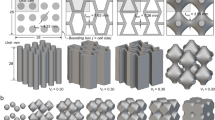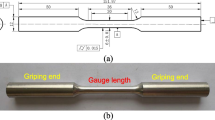The hoop tensile strength of a composite pipe was measured experimentally using the split-disk test method. Then, a finite-element modeling was performed to simulate the split-disk test, and the progressive damage modeling was carried out to predict the maximum load the ring specimen representing the hoop tensile strength can carry. The progressive damage modeling was utilized in the context of continuum damage mechanics, where a failed ply is replaced by a virtual continuum ply with reduced mechanical properties. To degrade the mechanical properties of the failed ply, the linear damage evolution law was used in combination with a linear material softening law. The hoop tensile strength predicted agreed with experimental observations very well, validating the finite-element modeling. The damage progression was monitored during different loading stages, and the sequence of experienced failure modes was investigated. The stress concentration factor at the root of a notch was computed based on the results of finite-element analysis. The stress distribution in the vicinity of the notch was investigated, and a simple manual method was proposed for obtaining the stress in the hoop direction. The stress obtained was compared with results of the numerical simulation, and a good accuracy of the method to determine stresses without employing the finite-element modeling was found to exist.









Similar content being viewed by others
References
AWWA manual M45. Fiberglass pipe design, 2nd Ed. American Water Works Association, Denver (2005).
ANSI/AWWA C950-01. Standard for fiberglass pressure pipe. American Water Works Association, Denver (2001).
ASTM D3517-06. Standard specifications for “Fibergalss” (glass-fiber reinforced thermosetting-resin). American Society for Testing and Materials, Philadelphia (2006).
ASTM D2412-02. Standard Test Method for Determination of External Loading Characteristics of Plastic Pipe by Parallel-Plate Loading. American Society for Testing and Materials, Philadelphia (2002).
ASTM D 1599-99. Standard test method for short-time hydraulic failure pressure of plastic pipe, tubing, and fittings. American Society for Testing and Materials, Philadelphia (1999).
H. Bakaiyan, H. Hosseini, and E. Ameri, “Analysis of multi-layered filament-wound composite pipes under combined internal pressure and thermomechanical loading with thermal variations,” Compos. Struct., 88, 532-541 (2009).
G. Meijer and F. Ellyin, “A failure envelope for ±60° filament wound glass fiber reinforced epoxy tubular,” Compos. Part A-Appl. S., 39, 555-564 (2009).
J.D.D. Melo, F.L. Neto, G.A. Barros, and F.N.A. Masquita, “Mechanical behavior of GRP pressure pipes with addition of quarts sand filler,” J. Compos. Mater., 45, No. 6, 717-726 (2010).
M. Bouhafs, Z. Sereir, and A. Chateauneuf, “Probabilistic analysis of the mechanical response of thick composite pipes under internal pressure,” Int. J. Pres. Ves. Pip., 95, 7-15 (2012).
L.A.L. Martins, F.L. Bastian, and T.A. Netto, “Structural and functional failure pressure of filament wound composite tubes,” Mater. Design, 36, 779-787 (2012).
H. Arikan, “Failure analysis of (±55°) filament wound composite pipes with an inclined surface crack under static internal pressure,” Compos. Struct., 92, No. 1, 182-187 (2010).
P. Mertiny, “Leakage failure in fibre-reinforced polymer composite tubular vessels at elevated temperature,” Polym. Test., 31, 25–30 (2012).
J. Xing, P. Geng, and T. Yang, “Stress and deformation of multiple winding angle hybrid filament-wound thick cylinder under axial loading and internal and external pressure,” Compos. Struct., 131, 868-877 (2015).
R. Rafiee, M. Fakoor, and H. Hesamsadat, “The influence of production inconsistencies on the functional failure of GRP pipes,” Steel Compos. Struct., 19, No. 6, 1369-1379 (2015).
R. Rafiee and F. Reshadi, “Simulation of functional failure in GRP mortar pipes,” Compos. Struct., 113, 155-163 (2014).
R. Rafiee, “Stochastic fatigue analysis of glass fiber reinforced polymer pipes,” Compos. Struct., 167, 96-102 (2017).
R. Rafiee and B. Mazhari, “Simulation of the long-term hydrostatic tests on glass fiber reinforced plastic pipes,” Compos. Struct., 136, 56-63 (2016).
R. Rafiee and B. Mazhari, “Modeling creep in polymeric composites: developing a general integrated procedure,” Int. J. Mech. Sci., 99, 112-120 (2015).
R. Rafiee and A. Amini, “Modeling and experimental evaluation of functional failure pressures in glass fiber reinforced polyester pipes,” Comp. Mater. Sci., 96, 579-588 (2015).
R. Rafiee, F. Reshadi, and S. Eidi, “Stochastic analysis of functional failure pressure in glass fiber reinforced polyester pipes,” Mater. Design, 67, 422-427 (2015).
R. Rafiee and B. Mazhari, “Evaluating long-term performance of glass fiber reinforced plastic pipes subjected to internal pressure,” Constr. Build. Mater., 122, 694-701 (2016).
R. Rafiee and F. Eslami, “Theoretical modeling of fatigue phenomenon in composites pipes,” Compos. Struct., 161, 256-263 (2017).
L. A. L. Martins, F. L. Bastian, and T. A. Netto, “The effect of stress ratio on the fracture morphology of filament wound composite tubes,” Mater. Design, 49, 471-484 (2013).
S. H. Yoon and J. O. Oh, “Prediction of long term performance for GRP pipes under sustained internal pressure,” Compos. Struct., 134, 185–189 (2015).
R. Rafiee and M. A. Torabi, “Stochastic prediction of burst pressure in composite pressure vessels,” Compos. Struct., 185, 573-583 (2018).
R. Rafiee, “Experimental and theoretical investigations on the failure of the filament wound GRP pipes,” Compos. Part B-Eng., 45, No. 1, 257-267 (2013).
H. Mahdavi, G. H. Rahimi, and A. Farrokhabadi, “Failure analysis of (± 55)9 filament-wound GRE pipes using explicit finite-element method: A comparison with the experimental method,” J. Fail. Anal. and Preven., 18, 1526-1533 (2018).
P. Shabania, F. Taheri-Behrooz, S. Maleki, and M. Hasheminasab, “Life prediction of a notched composite ring using progressive fatigue damage models,” Compos. Part B-Eng., 165, 754-763 (2019).
ASTM D 2290-04. Standard test methods for apparent tensile strength of ring or tubular plastics and reinforced plastics by split disk method. American Society for Testing and Materials, Philadelphia (2004).
ASTM D 3171-06. Standard test methods for constituent contents of composite materials. American Society for Testing and Materials, Philadelphia (2006).
R. Rafiee and M. R. Habibagahi, “On the stiffness prediction of GFRP pipes subjected to transverse loading,” KSCE J. Civ. Eng., 22, No. 11, 4564-4572 (2018).
R. Rafiee and M. R. Habibagahi, “Evaluating mechanical performance of GFRP pipes subjected to transverse loading,” Thin Wall. Struct., 131, 347-359 (2018).
C. C. Chamis, Simplified composite micromechanics equations for strength, fracture toughness and environmental effects, Technical Memorandum N84–27832, NASA, Lewis Research Center, Cleveland - Ohio - USA (1984).
I. Lapczyk and A. Hurtado, “Progressive damage modeling in fiber-reinforced materials,” Compos. Part A-Appl. S., 38, 2333-2341 (2007).
P. P. Camanho and C. G. Davila, “Mixed-mode decohesion finite-elements for the simulation of delamination in composite materials,” NASA/TM- 2002–211737, 1–37 (2002).
E. J. Barbero, F. A. Cosso, R. Roman, and T. L. Weadon, “Determination of material parameters for Abaqus progressive damage analysis of E-glass epoxy laminates,” Compos. Part B-Eng., 46, 211-220 (2013).
P. Areias, J. Reinoso, P.P. Camanho, J. César de Sá, and T. Rabczuk, “Effective 2D and 3D crack propagation with local mesh refinement and the screened Poisson equation,” Eng. Fract. Mech., 189, 339-360 (2018).
P. Areias, T. Rabczuk, and M.A. Msekh, “Phase-field analysis of finite-strain plates and shells including element subdivision,” Comput. Method. in Appl. M., 312, No. C, 322-350 (2016).
T. Rabczuk, P. M. A. Areias, and T. Belytschko, “A meshfree thin shell method for non-linear dynamic fracture,” Int. J. Numer. Meth. Eng., 72, No. 5, 524-548 (2007).
F. Taheri-Behrooz and N. Bakhshi, “Neuber’s rule accounting for the material nonlinearity influence on the stress concentration of the laminated composites,” J. Reinf. Plast. Comp., 36, No. 3, 214-225 (2016).
N. Bakhshi and F. Taheri-Behrooz, “Length effect on the stress concentration factor of a perforated orthotropic composite plate under in-plane loading,” Int. J. Compos. Mater., 1, No. 1, 71-90 (2019).
S. S. Samareh-Mousavi, S. Mandegarian, and F. Taheri-Behrooz, “A nonlinear FE analysis to model progressive fatigue damage of cross-ply laminates under pin-loaded conditions,” Int. J. Fatigue, 119, 290-301 (2019).
A. Shirkavand, F. Taheri-Behrooz, and M. Omidi, “Orientation and size effect of a rectangle cutout on the buckling of composite cylinders,” Aerosp. Sci. Technol., 87, 488-497 (2019).
Author information
Authors and Affiliations
Corresponding author
Additional information
Russian translation published in Mekhanika Kompozitnykh Materialov, Vol. 56, No. 4, pp. 631-648, July-August, 2020.
Rights and permissions
About this article
Cite this article
Rafiee, R., Abbasi, F. Numerical and Experimental Analyses of the Hoop Tensile Strength of Filament-Wound Composite Tubes. Mech Compos Mater 56, 423–436 (2020). https://doi.org/10.1007/s11029-020-09894-2
Received:
Revised:
Published:
Issue Date:
DOI: https://doi.org/10.1007/s11029-020-09894-2




